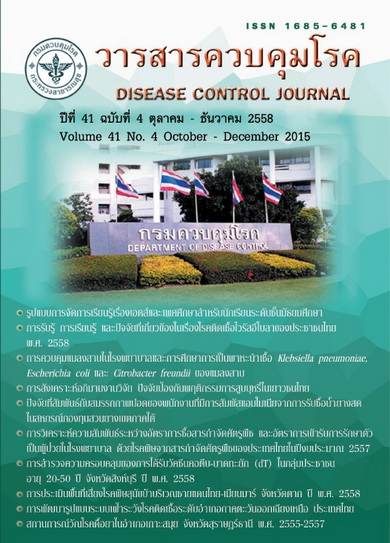An analysis of relationship between pesticides purchasing rate and admission rate from pesticides toxicity in Thailand, fiscal year 2014
DOI:
https://doi.org/10.14456/dcj.2015.6Keywords:
agriculture, pesticides, admission, suicidal attemptAbstract
The purpose of this study was to find relationship between rate of pesticides purchasing by farmers and admission rate due to related pesticides toxicity. The study included both the admissions from accident and from suicidal attempts. Admission data from nationwide hospitals in fiscal year 2014 was retrieved from National Health Security Office and was filtered for admissions from acute pesticides toxicity. The data was summarized to provincial level and grouped by causative pesticides. The purchasing data was retrieved from Bank for Agriculture and Agricultural Cooperatives and was summarized to provincial level. The data was joined together and analyzed. Linear relationship was found between the admission rate (number of admissions per 100,000) from accidental pesticides toxicity and the rate of purchasing (pesticide cost/population) and between the admission rate from pesticides related suicidal attempt and the rate of purchasing. Relationships between subgroups of purchasing and related toxicity were also found. The conclusion was that the more pesticides bought, the more admissions from toxicity, so registration and distribution of highly toxic pesticides should be strictly controlled. Risk communication on unsafe application should be emphasis. More research on safety of pesticides applying should be done. Organic agriculture should be promoted.
Downloads
References
2. พิบูล อิสสระพันธุ์. สถานการณ์ความเสี่ยงของเกษตรกรจากสารเคมีกำจัดศัตรูพืชและการป่วยเฉียบพลัน. สำนักงานกองทุนสนับสนุนการสร้างเสริมสุขภาพ (สสส.), บรรณาธิการ. การประชุมวิชาการเพื่อการเฝ้าระวังสารเคมีทางการเกษตร ครั้งที่ 1; วันที่ 16-17 มิถุนายน 2554; โรงแรมเซ็นจูรี่พาร์ค. กรุงเทพมหานคร: 2011. หน้า 58-64.
3. David Gunnell, Michael Eddleston. Suicide by intentional ingestion of pesticides: a continuing tragedy in developing countries. International Journal of Epidemiology [Internet]. 2003 [cited 2015 Sept 9];32:902-9. Available from: http://ije.oxfordjournals.org/content/32/6/902.full.pdf
4. สำนักนโยบายและยุทธศาสตร์ สำนักปลัดกระทรวงสาธารณสุข. แนวทางมาตรฐานการให้รหัสโรค (Standard Coding Guidelines) ฉบับ 2014. กรุงเทพมหานคร: สำนักงานกิจการโรงพิมพ์ องค์การสงเคราะห์ทหารผ่านศึกในพระบรมราชูปถัมภ์; 2557.
5. ภูษณิศา ฉลาดเลิศ, พิบูล อิสสระพันธุ์, วีณา ภักดีสิริวิชัย, วงศกร อังคะคำมูล. กลยุทธ์การจัดทำ Data Mining ระหว่างข้อมูลการเจ็บป่วยจากสารกำจัดศัตรูพืช กับข้อมูลการใช้สารกำจัดศัตรูพืชภาคการเกษตร จำแนกจังหวัด ปี 2556. กลุ่มสื่อสารสาธารณะและพัฒนาเครือข่าย, บรรณาธิการ. การประชุมวิชาการป้องกันควบคุมโรคจากการประกอบอาชีพและสิ่งแวดล้อมแห่งชาติ ครั้งที่ 7 ปี พ.ศ. 2558; วันที่ 25-27 กุมภาพันธ์ 2558; โรงแรมรามาการ์เดนท์. กรุงเทพมหานคร. นนทบุรี: 2015. หน้า 16.
6. ศูนย์มาตรฐานรหัสและข้อมูลสุขภาพแห่งชาติ. ICD-10 TM Online [Internet]. 2015 [cited 2015 Sept 9]. Available from: http://www.thcc.or.th/ICD-10TM/1/ icd10tm.html
7. Lawrence Joseph. Goodness of fit in linear regression [Internet]. 2006 [cited 2015 Sept 9]. Available from: http://www.medicine.mcgill.ca/epidemiology/joseph/ courses/EPIB-621/fit.pdf
8. Extension Toxicology Network. Zinc Phosphide [Internet]. 1993 [cited 2015 Sept 9]. Available from: http://pmep.cce.cornell.edu/profiles/extoxnet/pyrethrins-ziram/zinc-phosphide-ext.html
9. David A. Freedman. The Ecological Fallacy [Internet]. 2002 [cited 2015 Sept 9]. Available from: http://www.stat.berkeley.edu/~census/ecofall.txt
10. WHO. The WHO recommended classification of pesticides by hazard and guidelines to classification 2009 [Internet]. 2009 [cited 2015 Sept 9]. Available from: http://www.who.int/ipcs/publications/pesticides_hazard_2009.pdf
Downloads
Published
How to Cite
Issue
Section
License
Articles published in the Disease Control Journal are considered as academic work, research or analysis of the personal opinion of the authors, not the opinion of the Thailand Department of Disease Control or editorial team. The authors must be responsible for their articles.


.png)



